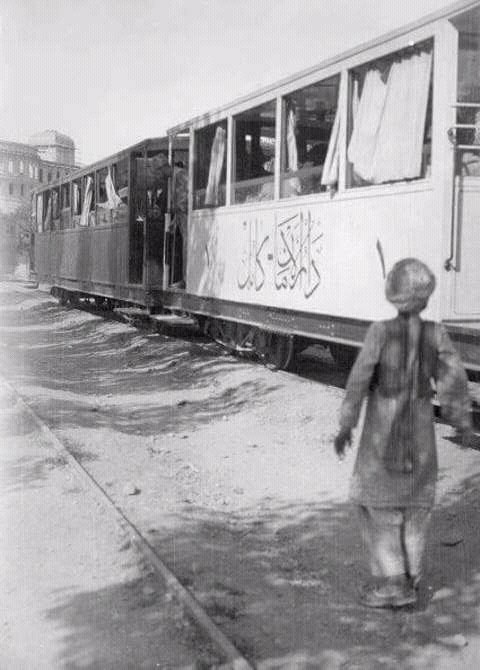Previous page: Khyber Pass railway
Amanullah became King of Afghanistan in 1919, and began to modernise the nation. His plans included railways.
Work began on a new European-style capital city at Darulaman,1 with an approximately 7 km roadside tramway linking the new development to Kabul.
Sheet I-42 J Kabul was originally compiled and published under the direction of the Surveyor-General of India 1916, and revised to 1940. This edition was published by the War Office in 1942 and reprinted by the US Army Map Service in October 1942. Original scale 1:253 440. The line was almost certainly disused by 1942. (Map courtesy of The General Libraries, The University of Texas at Austin)
Three small steam locomotives were acquired from Henschel of Kassel in Germany, and possibly either some carriages or underframe components to use with locally-built bodies.
On 15 December 1922 The Locomotive reported “Travellers from Afghanistan state a railway is being laid down for a distance of some six miles from Kabul to the site of the new city of Darulaman, and also that some of the rolling stock for it is being manufactured in the Kabul workshops.”2
Wilhelm Rieck of Berlin was in Kabul in 1923. He was one of a number of Germans who worked in Afghanistan by request of King Amanullah, and was in charge of building electrical installations, in particular at Darulaman palace. He travelled to Kabul, Kandahar, India, and Teheran taking photographs, and his great-grandson Werner Müller sent me these two photos of the railway. The Germans also built a school, which has a website which shows some of Rieck’s photos
In August 1928 The Locomotive reported "the only railway at present in Afghanistan is five miles long, between Kabul and Darulaman."3
King Amanullah was overthrown in January 1929, and the railway fell out of use at some point.

AFGHANISTAN’S ONLY STEAM TRAIN (RUNS BETWEEN KABUL AND DAR-UL-AMAN) – from the book War: Uprising in Afghanistan by Yevgeniy Shuan.
The locomotives were put into store in the two-road engine shed, then became part of the collection of the National Museum of Afghanistan.
Two of the locos were photographed by Frank Selman in 1975, when they were still in the shed. On the side of one locomotive was some c.1975 graffiti in Pashtu, saying (roughly) In memory of us here from [the name of a school] on this plaque
, followed by several names such as Ahdur Rahim, Matollah and Sultan Mahmed. It seems some schoolchildren visited the Kabul Museum opposite the engine shed, and one of them had a piece of crayon in his pocket.
![[Photo of loco shed. Frank Selman, 1975]](/images/rail/af-darulaman-shed-small.jpg) |
![[Photo of loco from rear. Frank Selman, 1975]](/images/rail/af-darulaman-loco-back-small.jpg) |
![[Photo of locomotive in the shed. Frank Selman, 1975]](/images/rail/af-darulaman-loco-small.jpg) |
Despite everything, the steam locomotives have survived, at first in their shed at the Kabul museum in Darulaman, then out in the open and now at the museum.
In January 2002 museum caretaker Omara Khan Masoudi said "These are historical artefacts and we want to keep them. Of course, it would be good to have a real railway now, that would be progress".4
On October 13 2004 Wim Brummelman found the three locos at Darulaman, in the yard behind the museum: most earlier sources had suggested there were only two locos.
![[Photo of locos in Kabul. Wim Brummelman]](/images/rail/af-locos2-small.jpg) |
![[Photo of locos in Kabul. Wim Brummelman]](/images/rail/af-locos3-small.jpg) |
![[Photo of locos in Kabul. Wim Brummelman]](/images/rail/af-locos4-small.jpg) |
![[Photo of locos in Kabul. Wim Brummelman]](/images/rail/af-locos5-small.jpg) |
![Henschel 19691 of 1923 [Photo of locos in Kabul. Wim Brummelman]](/images/rail/af-locos6-small.jpg) |
![[Photo of locos in Kabul. Wim Brummelman]](/images/rail/af-locos7-small.jpg) |
![[Photo of locos in Kabul. Wim Brummelman]](/images/rail/af-locos8-small.jpg) |
Updates
Updates on the Darulaman railway.
Next page: King Amanullah’s travels
References
- Dawn of another era, Railway Gazette International, August 1976, p317, accessible at University of York ↩
- The Locomotive Magazine, 1922-12-15, p379 ↩
- The Locomotive Magazine, 1928-08-15, p262 ↩
- Afghan rail plan among proposals for donors, CNN News report, from Reuters, 2002-01-21 ↩

![Map of the Kabul to Darulaman railway, Afghanistan [Map showing Kabul to Darulaman tramway]](/images/rail/af-kabul1942.jpg)

![[Photo of the first train]](/images/rail/af-first-train-small.jpg)
![[Photo of track]](/images/rail/af-track-small.jpg)

![[Photo of locos in Kabul. Wim Brummelman]](/images/rail/af-locos1.jpg)
Perhaps the locals could divert their energies into a new direction – running a preserved railway for the entertainment of all!
The locomotives are 762mm gauge 0-4-0T built by Henschel in 1923 works numbers 19680 19681 19691
A fast train out from Kabul would be most welcome by hundreds, if not thousands of Internally Displaced Persons now in grave peril and ‘camped’ around the city. Bring on the German Railway Engineers a.s.a.p.
Germany is the afghanistans king big freind
War destroy every thing of afghanistan,i wish
Germany help afghanistan to improve industry ,Germany is an advanced country in industry and economy. I wish Afghanistan would be helped like in the time of the king amanullah khan